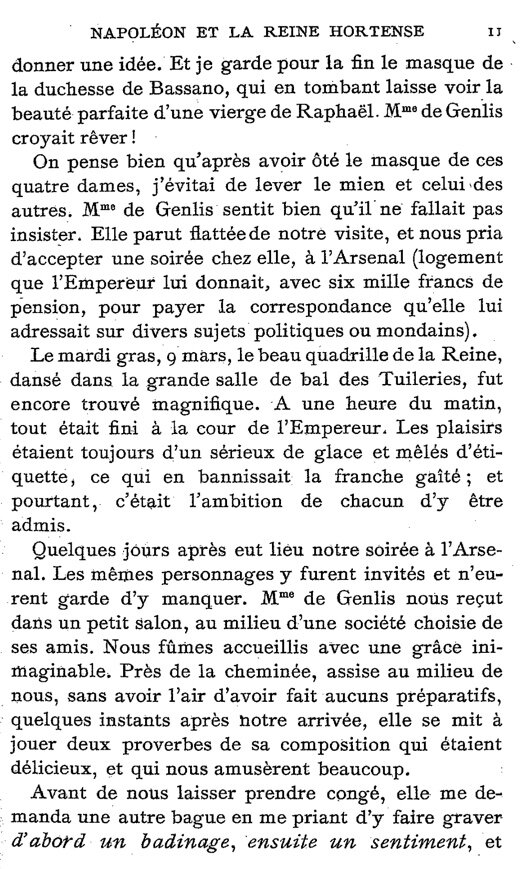The following is from the book, Napoleon and Queen Hortense by Hortense’s reader Madame Cochelet. When we last left off it was still 1813 - a year of downturn - Madame Cochelet and her friends were wearing costumes and being pretty silly.
Madame Cochelet writes about unmasking pretty faces to the delight of the renowned writer Madame de Genlis.
The Duchess of Bassano.
[a painting by Titian would] give an idea [of her beauty]. And I save for the end the reveal of the mask of the Duchess of Bassano, who in the falling of the mask reveals the perfect beauty of a virgin of Raphael.
Mme. de Genlis thought she was dreaming! After removing the mask of these four ladies, I avoided lifting mine and that of the others, Madame de Genlis felt that one should not insist on more reveals.
She seemed flattered by our visit, and asked us to accept an evening with her at the Arsenal (an accommodation which the Emperor gave her, with a six thousand francs pension, to pay for the correspondence which she addressed to him on various subjects regarding politics or world events).
On Mardi Gras, March 9, the beautiful quadrille of the Queen, danced in the large ballroom of the Tuileries, was still found to be magnificent. At one o'clock in the morning it was all over at the Emperor's court.
The pleasures were always so icy and mixed with rigid etiquette [at the time of Marie Louise], which banished sincere gaiety; and yet it was everyone's ambition to be admitted.
A few days later took place our evening at the Arsenal. The same personages were invited and were careful not to miss it. Madame de Genlis received us in a small salon, in the midst of a lovely group chosen by her friends. We were greeted with unimaginable grace. Near the fireplace, sitting amongst us, without seeming to have made any preparations, a few moments after our arrival, she began to share two proverbs of her composition which were delicious, and which amused us a lot.
Before letting us take leave, she asked me for another ring, asking me to engrave “a banter first, then a sincere feeling”, and some time after, she sent me the ring in black enamel with a little negro head that I had given her.
She had it engraved with the phrase: “a moment is enough for you”.
The Queen went to spend a few days at Trianon with the Emperor and the Empress. The Emperor fell from a horse which frightened everyone; but luckily we were left with only fear. One morning I went to Trianon to see the Queen in her apartment; I was the first to bring her a black velvet bag with a gold clasp, something very new then.
She found the invention very pretty and very convenient; because, until then, without pockets and bags, one carried their handkerchief and fan in one’s hand.
From that moment, we made bags of all designs; Empress Joséphine received one in gold, ornately lined with white satin, with tassels in fine pearls and emeralds and also surrounded by pearls and emeralds.
I remember asking to see, at Trianon, the large apartments that I had never seen, and to admire there superb cups and vases in malachite which were very large. The Queen told me that these were the gifts which the Emperor of Russia had made to Napoleon during the peace of Tilsit; he had also given him a fine sable sable fur, which the Emperor had given to his sister Princess Pauline; then a beautiful muff, also of a magnificent marten, which, after having been given to the Empress Josephine, became the property of the Queen. I don't know if it was the fall from Napoleon horse’s [that made everyone sad but]
To be continued.
Madame de Genlis in younger days.
Ce qui suit est tiré du livre Napoléon et la reine Hortense du lecteur d'Hortense Madame Cochelet. Lorsque nous nous sommes arrêtés pour la dernière fois, c'était encore en 1813 - une année de récession - Mme Cochelet et ses amis portaient des costumes et étaient plutôt frivoles. Madame Cochelet écrit sur le démasquage de jolis visages pour le plus grand plaisir de la célèbre écrivaine Madame de Genlis.





